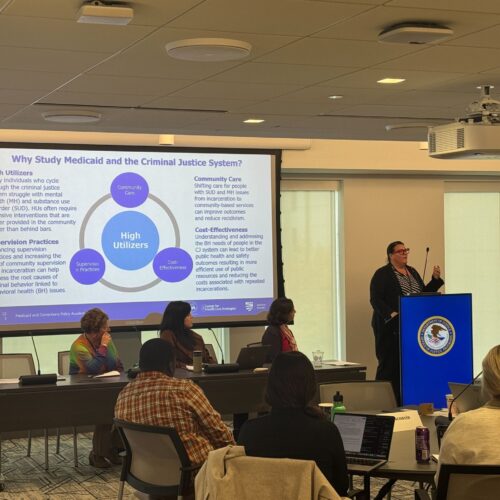Berrien County, MI, Expands Training, Collaboration Around Juvenile Justice
Michigan—The Family Division of the Berrien County Trial Court decided in 2001 that its juvenile justice practices simply weren’t working.
“We had 125 of our youth in out-of-home, residential placements throughout Michigan and even in other states,” said Elvin Gonzalez, the court’s Family Division administrator. “We saw those numbers, and we knew we could do better.”
That meant restructuring the county’s juvenile justice procedures around evidence-based practices, starting by using risk assessments to determine which youth were more likely to commit another offense and thus required more intensive interventions and supervision.
“We started using the risk assessments and focusing our resources on the highest-risk youth,” Gonzalez said. Rather than rely on intuition or a one-size-fits-all approach, “we were then able to match individual youth with the most appropriate services for them.” The Family Division also made it a priority to offer services in the community rather than at far-flung residential facilities, which data show is not only a more effective way to offer rehabilitative treatment, but which also saved the county money.
“The average out-of-home stay is 12 to 14 months, and the average cost is $80,000 to $90,000 per youth,” said Gonzalez. “We found that we can offer comparable services in the community to a youth and his or her family for $5,000 to $8,000. And the money we saved we were able to reuse—to expand those community-based services to more youth.”
Today, Berrien County averages fewer than 40 youth in out-of-home placements at any given time.
Intentional Rehabilitation
Another significant change was that the county court’s Family Division started to consider youth as products of their “ecology,” as Gonzalez describes it. “Kids live in an ecology,” he said, “which is in large part their family system, their neighborhood, and their school. But even youth who end up in an out-of-home placement are going to return to their families—and if their home situation hasn’t improved then the chances of their recidivating are high.”
So the Family Division began partnering more effectively with county law enforcement, mental health and child welfare agencies, and schools, to provide collaborative case management for youth. It also started being more intentional about integrating families into their youth’s rehabilitation efforts, through programs like Functional Family Therapy.
Mental Health Care
Berrien County has also recently started a mental health “navigator” program, which is an effort to keep at-risk youth who may have mental health issues out of the juvenile justice system, and to get them the treatment they need. It works like this: when law enforcement officers respond to a situation involving a youth they believe may have mental health issues, they contact a trained mental health “navigator” (a local volunteer who has received more than 40 hours of instruction on community mental health resources), who in turn gets in touch with the youth’s family and explains the navigator program and its objectives. If the family agrees to enter the program—and Gonzalez says almost all families do—then the youth spends a session with a master’s-level clinician, who evaluates the youth’s needs and then offers treatment options and suggestions to the family.
“We’re trying to intercept kids before they get involved with the courts,” Gonzalez said. “We don’t want it to be the case that youth have to get arrested before they get help. We need to build some viable off-ramps from the highway to the juvenile justice system.”
Berrien County is also working to increase the knowledge and skills of its first responders by providing Mental Health First Aid and crisis intervention training (CIT) to help them identify and interact with youth and adults who may be experiencing a mental health crisis. CIT instructors explain different kinds of mental disorders, their causes and symptoms, how they might appear, and how best to deal with people who have them.
Funding and Training
Berrien County has been able to undertake and expand many of these efforts in part thanks to a 2014 Justice and Mental Health Collaboration Program (JMHCP) Juvenile Expansion grant. Gonzalez recently attended one of the CSG Justice Center Training Summits in New York City to learn more about organizing his county’s JMHCP grant program and maximizing its effectiveness.
These two-day training summits gather representatives from jurisdictions and organizations that were awarded the same type of Bureau of Justice Assistance grant—an approach that allows for more targeted training and also encourages collaboration between grantees. The CSG Justice Center hosted two summits in June, the first for Second Chance Act (SCA) Mentoring grantees and the second, which Gonzalez attended, for both SCA Juvenile Demonstration and JMHCP Juvenile grantees.
When returning to their communities from criminal justice settings, people with behavioral health needs face barriers in accessing…
Read MoreNew Hampshire Department of Corrections Commissioner Helen Hanks presents at the Medicaid and Corrections Policy Academy in-person meeting.
Read More Assigned to the Cloud Crew: The National Incarceration Association’s Hybrid Case Management for People with Behavioral Health Needs
Assigned to the Cloud Crew: The National Incarceration Association’s Hybrid Case Management for People with Behavioral Health Needs
When returning to their communities from criminal justice settings, people with behavioral…
Read More Meet the Medicaid and Corrections Policy Academy Mentor States
Meet the Medicaid and Corrections Policy Academy Mentor States
New Hampshire Department of Corrections Commissioner Helen Hanks presents at the Medicaid…
Read More Six States Commit to Improving Statewide Strategies to Address Youth Crime, Violence and Behavioral Health
Six States Commit to Improving Statewide Strategies to Address Youth Crime, Violence and Behavioral Health
The Council of State Governments (CSG) Justice Center has launched the Collaborating…
Read More Bipartisan Group of 88 Lawmakers Push for Continued Funding for Reentry and Recidivism Programs
Bipartisan Group of 88 Lawmakers Push for Continued Funding for Reentry and Recidivism Programs
A bipartisan group of 88 lawmakers, led by Representatives Carol Miller (R-WV)…
Read More










